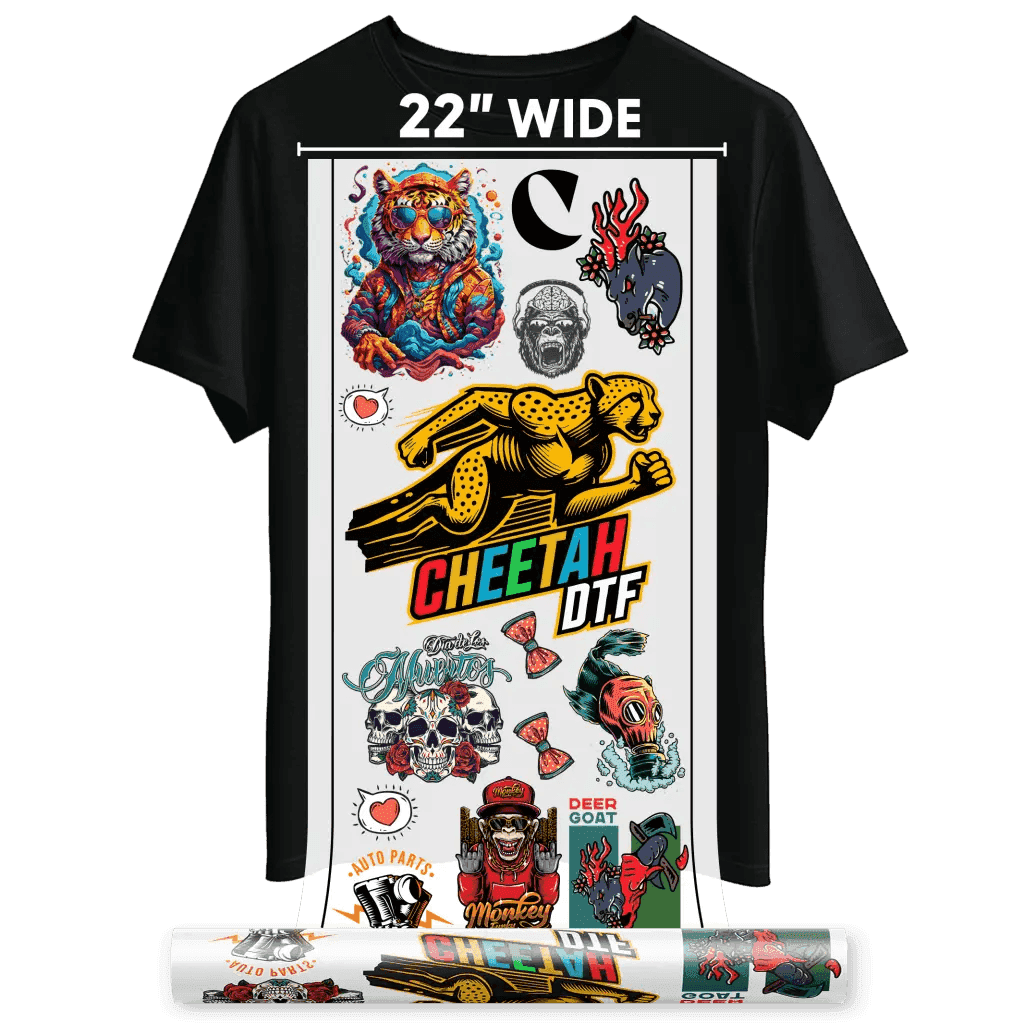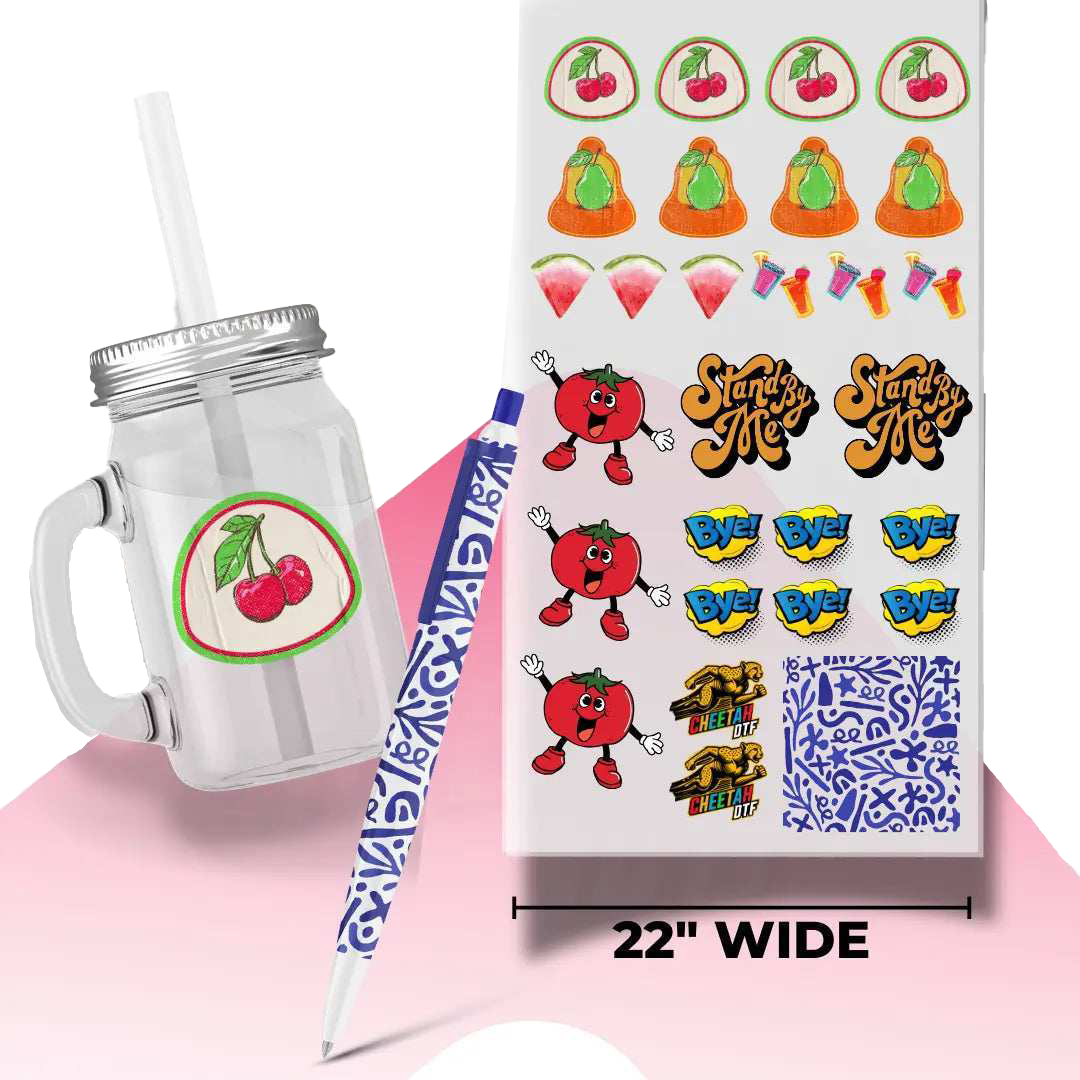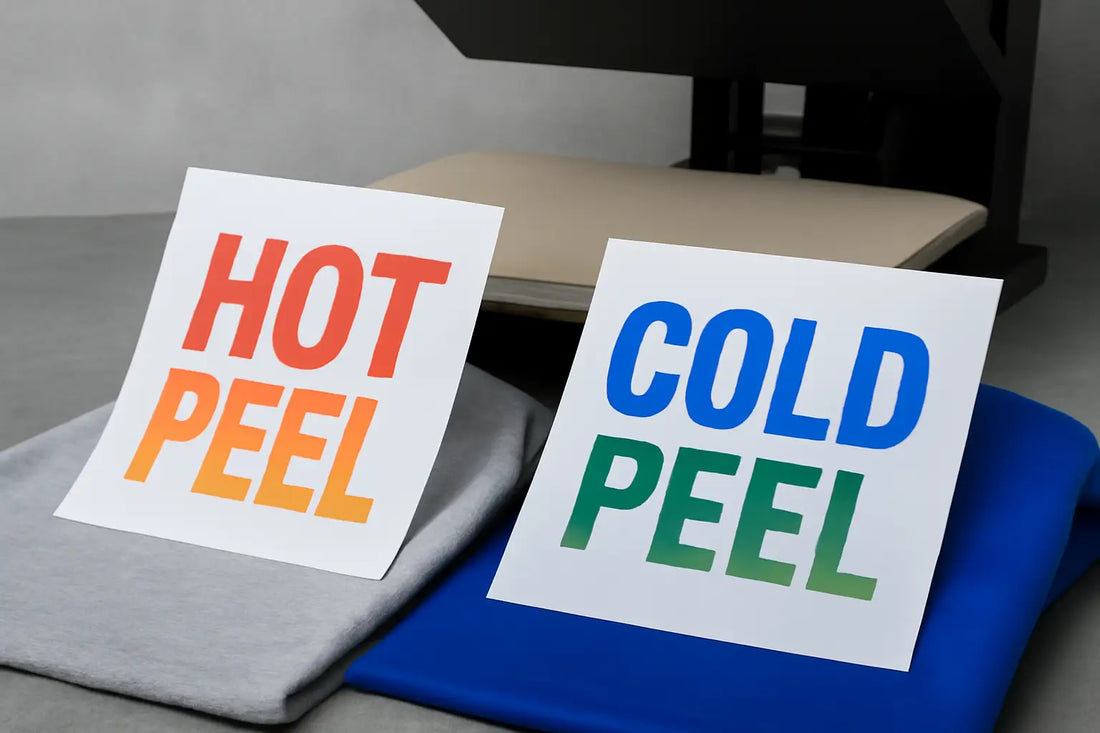Hot Peel vs. Cold Peel DTF Transfers: How Each Applies to Different Fabrics
With their versatility, high-definition colors, and simplicity of use, direct-to-film (DTF) transfers have transformed apparel manufacturing. If you have decided to use DTF for your custom apparel printing business, then there are a few critical decisions you need to make. One of them is: Hot Peel vs. Cold Peel DTF.
Understanding the difference between hot and cold peel DTF helps ensure you get the best results across applications. Every kind has distinct features, application methods, and best use cases depending on the fabric.
In this post, we will examine five common fabric types and their reactions to hot and cold peels to help you make an informed choice.
Cotton
Hot Peel:
On cotton, when velocity is crucial, hot peel DTF films excel. Peeling the film right after pressing saves manufacturing time. Results on thicker cotton clothing can, however, be erratic, which might cause little edge lifting if the pressure or heat is not ideal. For light cotton tees or mass manufacturing settings where speed outweighs accuracy, hot peel is the most suitable option. A hot peel makes DTF printing hot peel a go-to for quick production runs.
Cold Peel:
Cotton responds well to cold peeling, but not as well as to hot peeling. If you allow the transfer to cool after pressing before peeling, you can improve ink bonding and lower the chance of lifting or ghosting. For high-quality or textured cotton, like ringspun or combed cotton, cold peel produces a smoother, more matte finish with a strong bond. When to use cold peel DTF depends on your production process. If you are not in a hurry or do not require bulk designs, cold peel is a more suitable option.
Polyester
Hot peel:
A cold peel vs. hot peel comparison is necessary when dealing with tricky synthetics like polyester. Due to the heat sensitivity of polyester fabric, hot peel films may be difficult to handle. High heat usually causes polyester to react, which leads to dye migration (color bleeding), particularly on sublimated apparel. Lower the temperature and reduce the dwell time if using a hot peel, as this can cause poor adhesion. Having said that, hot peel works for quick-turnaround polyester projects when dialed in appropriately.
Cold Peel:
Usually, the better option for polyester is cold peel. The slower cooling procedure helps to achieve a softer attachment and reduces the likelihood of dye migration or scorching. For athletic apparel, uniforms, or promotional poly gear when durability and finish are more important than speed, cold peel films are perfect. Always try cold peel settings to avoid sheen or pressure marks on light or stretchy poly clothes to achieve the best peel for vibrant DTF results.
Blends: Mixtures of Cotton/Poly
Hot Peel:
Hot peel transfers may have trouble with consistency on blends. The composition of cotton-poly combinations ranges (e.g., 50/50, 65/35); hence, hot peel can react differently depending on the fabric ratio. You run the danger of little lift or uneven edges for lighter blends with more poly content. Hot peel performs well for budget tees or time-sensitive manufacturing runs when configured properly. Follow DTF hot peel instructions to minimize inconsistencies and achieve better output on blends.
Cold Peel:
Cold peel has enhanced blend flexibility. It lets transfers settle completely across cotton-poly fibers for a strong adhesion. Use cold peel for mid to high-quality blended garments where both performance and appearance are paramount. It’s also ideal for heat-sensitive triblends or fashion tees. The end result is smoother, more durable, and often more wash-resistant. Refer to a DTF hot peel guide to compare ideal temperatures and fabric compatibility before making a decision.
Nylon
Hot Peel:
Generally speaking, hot peel is not advised for nylon. Nylon's low heat tolerance and slippery surface make it difficult for heat transfers to adhere right away. Frequently attempting hot peel results in patchy designs, as the ink rises with the film. Adhesion might fade with several washes or with stretching, even when it does work. In this context, cold peel works better, and the cold peel DTF temperature plays a critical role in ensuring the transfer bonds properly with nylon.
Cold Peel:
For nylon, cold peel is the better alternative, as it provides superior grip and long-term durability, especially for goods like jackets, bags, or rainwear, when using the correct adhesive powder and preparation. Letting the transfer cool helps the glue fully cure and attach to the synthetic surface. Always check settings and use low-temp adhesive powder before application to maximize the color vibrancy.
Lycra or spandex
Hot Peel:
For spandex or Lycra blends, hot peel is dangerous. These elastic fabrics can cause cracking or lifting at the edges because they do not react favorably to abrupt film removal. The stretchiness of hot peel stickers can cause early wear or ink flaking after a few washes, even if they initially appear to be excellent. It is practical only for simple designs on low-stretch goods; even then, results vary. Some may view this as one of the key disadvantages of cold peel DTF, but cold peel remains more suitable overall.
Cold Peel:
On spandex and Lycra, cold peel is much more dependable. The cooling process allows the ink to settle and spread somewhat on the cloth, thereby forming a longer-lasting attachment. It ensures that the pattern remains intact during wear and reduces stress on the transfer when peeling. Leggings, performance wear, and any clothing needing flexibility and resilience should all benefit from cold peel. Pay attention to DTF cold peel time to ensure proper settling for maximum durability.
Metal Surfaces (Signs and Tumblers)
Hot Peel:
A hot peel on metal can be successful if the surface has been coated with heat-resistant coatings and if the pressure is even. However, because metal retains heat, the transfer cannot separate cleanly unless conditions are perfect. If peeled too early, there is the risk of smudging or ghosting. Rigid surfaces, such as metal, should not be initially chosen for hot peel. Still, comparing methods for these substrates requires attention to the difference between hot and cold peel DTF for hard surfaces.
Cold peel:
On metal, cold peel offers a more regulated result. Allowing the ink to solidify properly on treated metal surfaces helps reduce the likelihood of residue or smearing by cooling the surface. This is perfect for coated tumblers, promotional metal cards, or custom signs. It gives a more professional finish and reduces the chance of spoiling a costly substrate. For rigid materials, this is clearly the best peel method for DTF.
Hot Peel vs. Cold Peel DTF: Which Peel Should You Choose
The fabric type, manufacturing speed, and preferred finish quality all affect the selection of hot peel and cold peel custom DTF transfers. For quick-paced settings using simple cotton or light blends, hot peel works well. Understanding the cold peel vs hot peel comparison is critical to optimizing output and avoiding errors.
Especially on synthetic, flexible, or sensitive textiles, cold peel yields better grade, long-lasting results. It’s often the best peel for vibrant DTF results when color depth and durability are priorities.
Investing time in testing both techniques across your fabric range is critical. Don't depend on one-size-fits-all. The correct peel option could mean the difference between a flawless finish and a pricey do-over. Understanding the right DTF hot peel instructions will prevent costly mistakes.
Why Choose Cheetah DTF for Your DTF Peels
With dependable adhesion, brilliant color, and professional consistency, Cheetah DTF offers high-quality hot peel transfers. Our products are rigorously tested on genuine fabrics, clearly labeled for easy use, and shipped promptly to keep your workflow moving smoothly. We ensure that every transfer meets the requirements of serious artists and companies with expert support and accurate printing.
Ready to order your DTF peel for the next collection? Try our DTF Sample Pack and UV DTF Sample Pack to test the quality.


